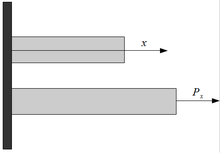traction
When traction is in physics ( statics a) in accordance with general usage force referred to in a body moves , see picture. As a force it has the dimension M · L · T −2 and its SI unit is the Newton .
Sometimes the tensile force (e.g. the tension of a bowstring ) is given in practice in kilograms instead of newtons. This specification therefore corresponds to the force that is required to hold a weight of the given gravity against the force of gravity .
In statics, the line of action of the tensile force is in the direction from the attachment point to the point of application of force, between which the body, rod, rope etc. lie. In this case, the tensile force results in a cutting reaction in the form of a normal force across the cross-section, in which a stress in the form of mechanical stresses occurs.
In statics, a tensile force is always defined as positive (+); a negative tensile force corresponds to a compressive force . The tensile force is positive if it works on its effective surface (also cut surface ) in the direction of its outwardly oriented normal as shown in the picture. A real body is stretched by a tensile force and compressed by a compressive force .
Often the tensile force is a diverted pressure or shear force , because adhesion and suction forces are comparatively weak. For example, pulling on a crane hook a load by using the slings pressed into the hook, which deflects the pressure force by its curved shape in a tensile force to the crane cable. In general, a force can be transmitted by connection techniques via form fit , force fit or material fit . In the case of a form fit, as with a crane hook, compressive forces act at right angles to the surfaces of the connection partners; in the case of a force fit, the force is introduced tangentially to the effective surface via static friction, as in the case of nodes . These forces are then diverted into tensile forces through power transmission .
Solid materials (rods, rods, ropes, chains, etc.) and material bonds can transmit tensile forces via atomic or molecular forces until their tensile strength is reached.
literature
- Herbert Balke : Introduction to Technical Mechanics . Strength theory. 3. Edition. Springer-Vieweg, 2008, ISBN 978-3-642-40980-6 , pp. 7th ff .
